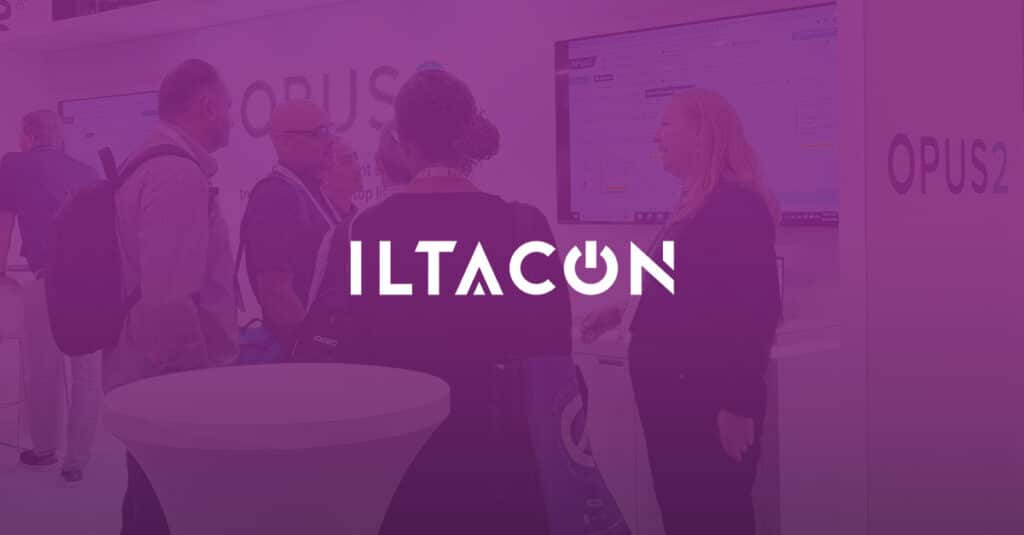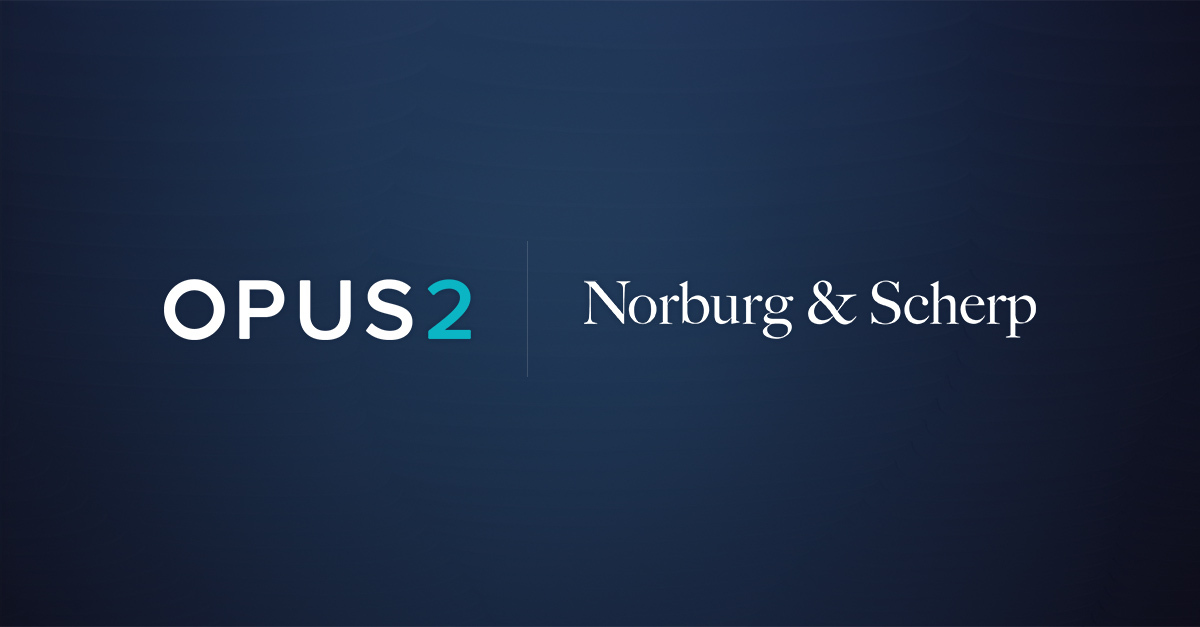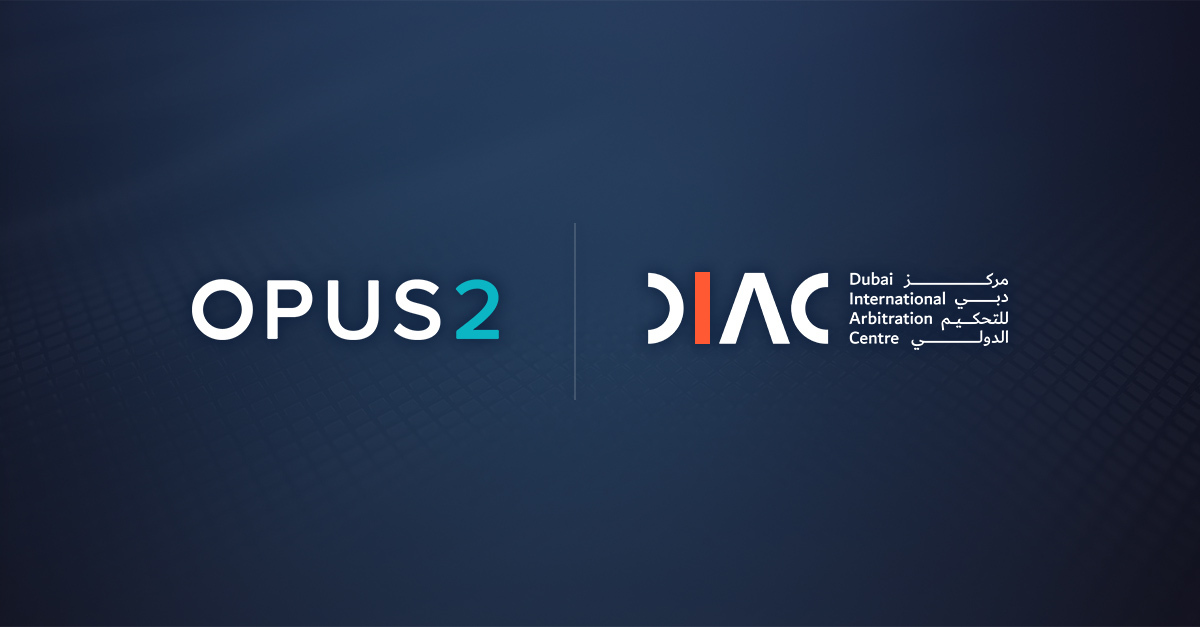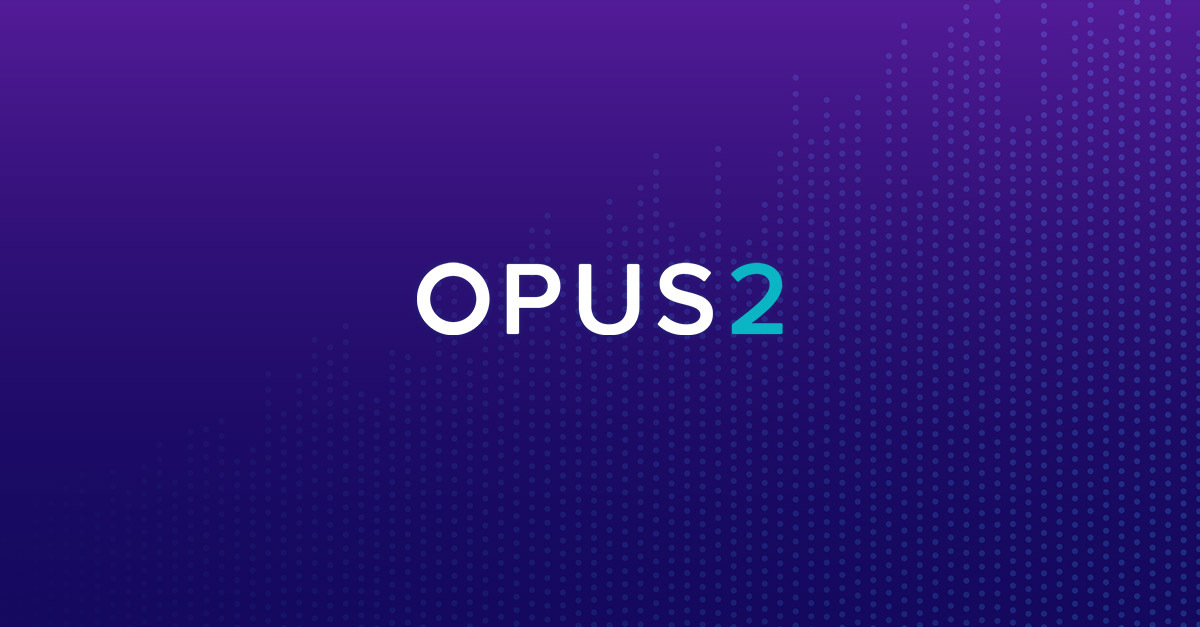At ILTACON 2024, the sessions explored a wide range of topics. From practical advice for day-to-day challenges to predictions for the future of AI in legal, the sessions were full of actionable advice and interesting insights.
As it is every year, the ILTACON agenda was packed with valuable content and there’s always a sense of wanting to be everywhere all at once. So, to make ILTACON insights more accessible both to busy attendees and those who couldn’t make it to the event this year, the Opus 2 team decided to divide and conquer. Here are our favorite six sessions, in no particular order.
The promises and potential perils of artificial intelligence: Navigating the AI jungle
Speakers
- Maribel Rivera | VP, Strategy and Client Engagement | ACEDS
- Julie Brown | Director of Practice Technology | Vorys, Sater, Seymour and Pease LLP
- Cat Casey | Chief Growth Officer | Reveal
- David Horrigan | Discovery Counsel and Legal Education Director | Relativity
It is well understood among legal tech experts that generative AI (GenAI) has tremendous potential to transform the business of law. However, if law firms want to turn that AI potential into proven value, they must be thoughtful in their approach. Julie Brown, Director of Practice Technology at Vorys, Sater, Seymour and Pease, LLP described her team’s role as “sellers” of new AI-enabled technology within the firm. They find the best way to sell tech is to show lawyers exactly how to use it within their processes and roles, making the value immediately clear.
Despite initial concerns about job security, David Horrigan observed a recent shift saying, “Tides are turning, people want AI.” Horrigan noted that the core eDiscovery tasks are the ones being used the most and document review is key. Brown agreed adding, “GenAI will not replace attorneys, but it will replace attorneys who don’t know how to use it.”
“GenAI will not replace attorneys, but it will replace attorneys who don’t know how to use it.” – Julie Brown
In addition to sharing their real-world experiences, the speakers also offered their perspectives on some of the latest guidelines, opinions, and cases involving GenAI. Cat Casey, Chief Growth Officer at Reveal discussed the importance of leveraging AI that uses a closed large language model (LLM) to protect both your data inputs and ensure outputs are based only on the information you’ve provided. She also recommended routinely reviewing your AI tools as well as the volume, variety, and velocity of data flowing into them.
The panel recommended four steps to avoid common AI pitfalls
- Establishing frameworks for governance and regulatory compliance
- Ensuring ample lawyer enablement and training on AI capabilities
- Finding the right balance between efficiency and legal integrity
- Building validation processes to ensure oversight of AI outputs
Despite current obstacles, the panel all agreed that firms will overcome them, and AI will play many roles in the future of legal work. “There’s a veritable cornucopia of resources on all the things AI can do,” Horrigan said, encouraging firms to continue exploring the possibilities and finding new ways to put AI to work.
See slides from this session
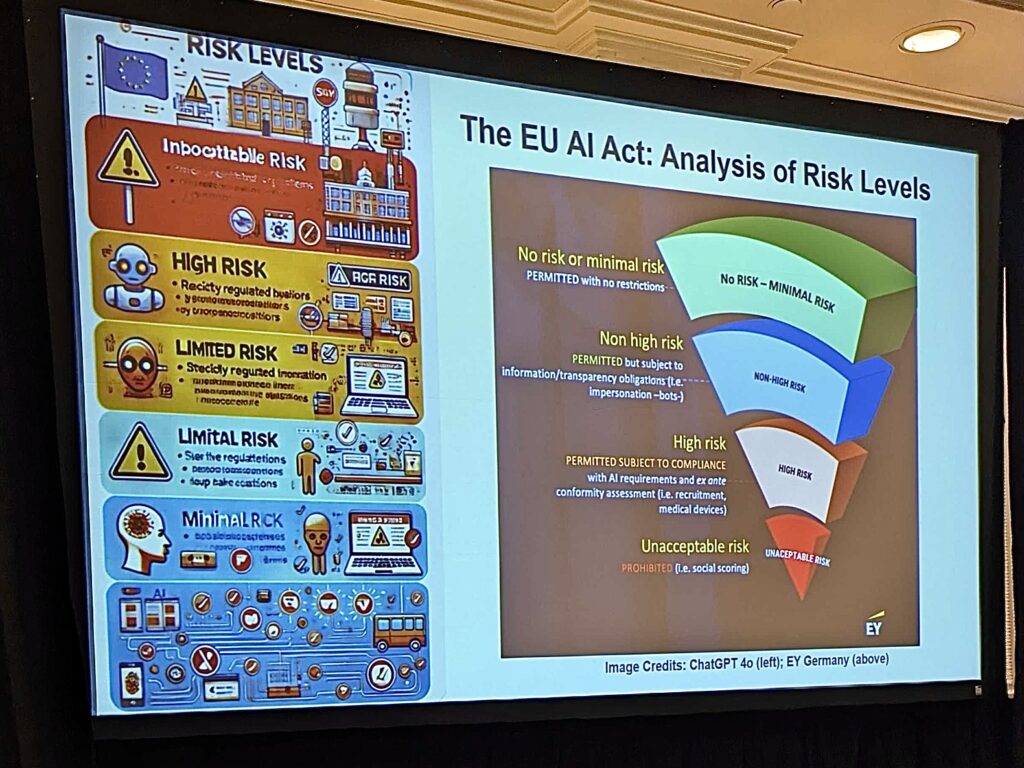
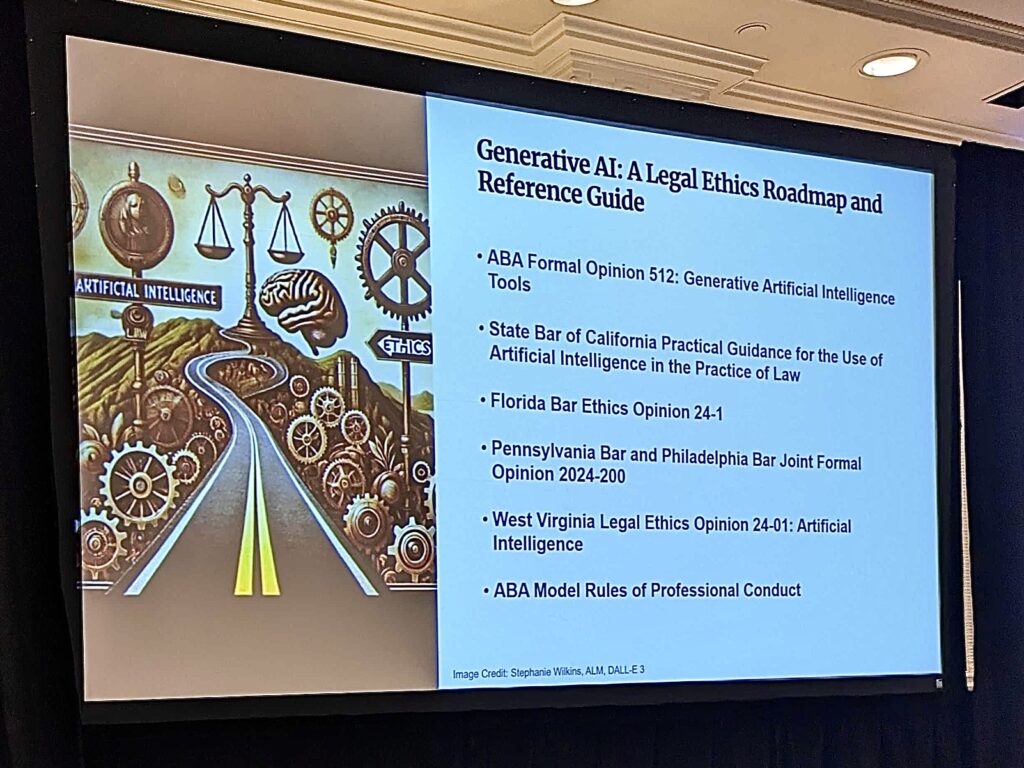
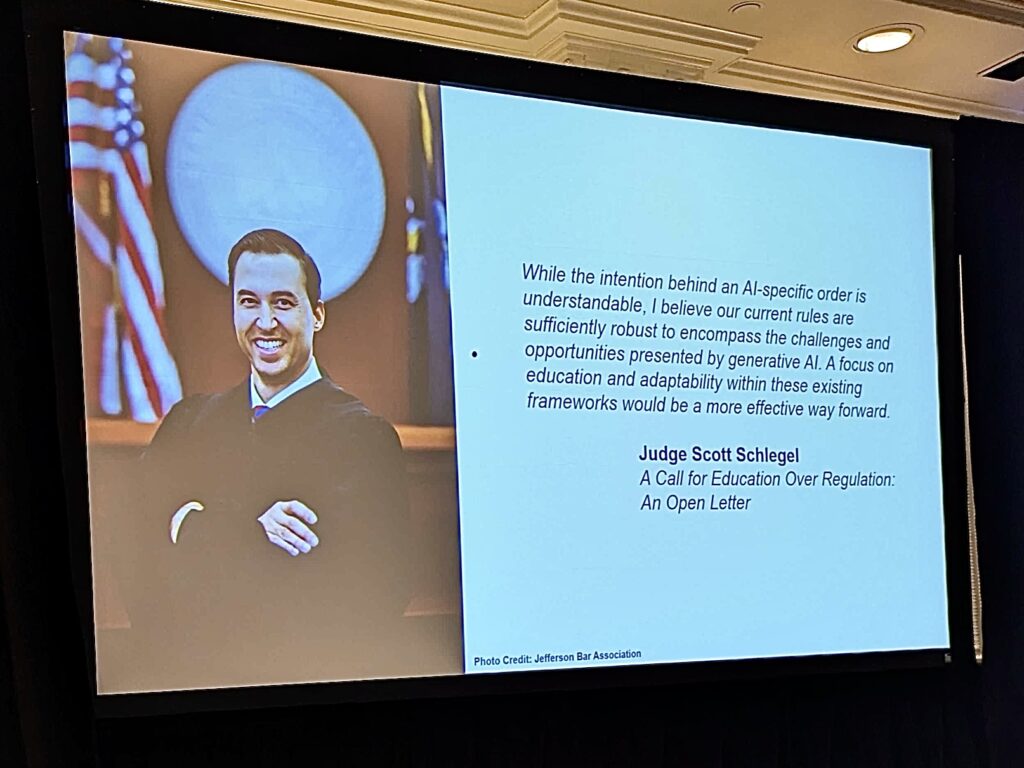
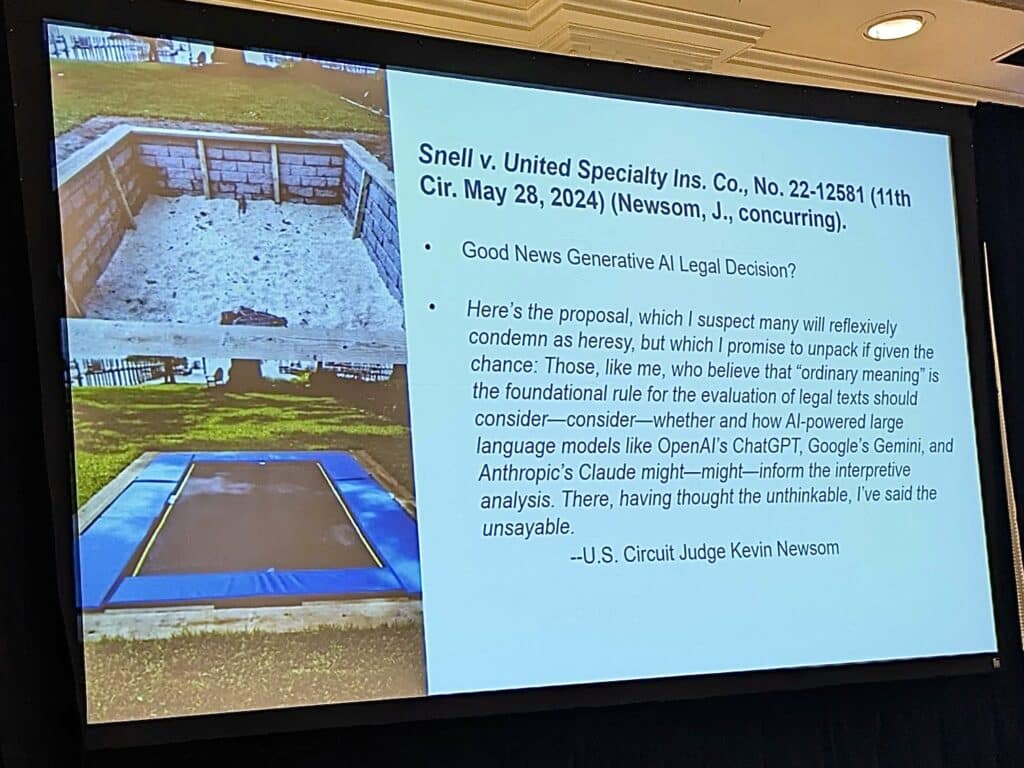

Will Carter
Chief Revenue Officer
Sustaining engagement for evolving technologies
Speakers
- Alex Chiang | Chief Customer Office | SimplyAgree
- Max Gladstone | Director of Innovation | Troutman Pepper
- Ana Toft-Nielsen | Professional Development Innovation Manager | Greenberg Traurig
Cloud-based technologies have changed the traditional technology rollout timeline. With increased accessibility and availability, law firms can invest in and implement new tools at an incredibly fast rate – which can be both a benefit and a challenge. On one hand, investing in innovation can enable teams to enhance efficiency while delivering greater value. At the same time, a feeling of constant change can discourage adoption.
This session at ILTACON 2024 delved into strategies for maintaining engagement and adoption in this dynamic environment. Here are the highlights.
Embracing evolution over change
In the session, the speakers discussed the difference between change and evolution. Change is hard and it often implies an abrupt disruption, while evolution is a gradual, strategic improvement. To secure better continual adoption, focus on how you can encourage evolution rather than implement change. Effective evolution requires time, patience and a thoughtful strategy. The panel offered other tips for success:
Identify technology champions
Work closely individuals who are enthusiastic about exploring new tools and functionality. Building a council of these evangelists can create a powerful influence network within the firm, helping to drive adoption and overcome resistance.
Drive awareness
Everyone in the firm is busy, so gaining visibility can be a challenge. Establish a multi-channel communication strategy to share information about new solutions, successes, and user benefits to enhance awareness. Transparency about implementation plans, updates, and firm expectations is key. It’s also crucial to focus messaging on the specific needs and benefits for the end users.
Leverage feedback
Use feedback from a pilot program to optimize processes, refine use cases, and demonstrate value before planning a firm-wide release. This user-centric approach not only improves the technology but also builds trust and buy-in across the firm. After a full rollout, create a feedback loop where user inputs are gathered, acted upon, and publicized within the firm.
Develop tailored training
As new solutions are implemented, proactively offer information, training, and support resources. Keep in mind the needs of different groups within the firm. Providing a variety of training resources, such as short videos and practical tips, helps employees continually improve their skills and stay engaged with new technologies. Additionally, offering office hours and regular training sessions can help maintain momentum and address challenges as they arise.
Lead by example
The session stressed the importance of earning buy-in from leadership as they set the tone for the rest of the firm. Their advocacy and example can encourage ongoing learning and accountability.
Celebrate successes
Whether through formal recognition programs or simple acknowledgments of effort, celebrating success is essential. These practices can reinforce the positive aspects of continual adoption and engagement.
Foster a culture of adaptability
Finally, the session highlighted the importance of building a firm-wide culture of adaptability. This culture helps promote a growth mindset, where developing new skills is rewarded and the fear of failure is minimized.
In summary, sustaining engagement for evolving technologies requires a comprehensive approach that includes encouraging evolution, enabling champions, ensuring training and feedback, securing leadership advocacy, and fostering a culture of adaptability. The insights shared during this session at ILTACON 2024 provide a valuable toolkit for firms looking to navigate the challenges of continuous technological evolution successfully.

Hilary Goldman
Senior Client Relationship Manager
From scratch to scale: Shaping a litigation support operation
Speakers
- Christina Natale | Director of Legal Industry Solutions | Hike 2
- Ann Halkett | Director, SOLVED eDiscovery Services | Alexander, Holburn, Beaudin + Lang LLP
- David Greetham | VP of Digital Forensics | Level Legal
- Joy Murao | Founder, CEO | Practice Aligned Resources

Litigation teams are constantly challenged to manage increasing workloads while maintaining efficiency and quality. This session at ILTACON 2024 addressed these challenges, offering valuable insights for teams looking to build repeatable processes and scale their litigation support operations effectively.
Tips for building a lean yet capable team
It won’t surprise you to know that your team is the most important factor when scaling. The session started by offering tips for building an ambitious, adaptable, consistent, and efficient team.
- Hire technology-savvy individuals
- Implement cross-training
- Encourage collaboration between paralegals and attorneys
- Challenge team members to grow their skills
- Invest in the right software
- Create detailed checklists, templates and how-to guides
- Emphasize ongoing training and technology adoption
Leveraging technology to streamline litigation
Many litigation support teams face the daunting task of building or improving their operations with limited resources, budget, staff, and organizational buy-in. However, the speakers emphasized that developing effective and efficient processes has become more accessible as firms adopt cloud-based solutions. However, it’s important to carefully consider if you need better technology or more people to meet your goals.
The right tools will help teams manage the many moving parts in litigation support, allowing them to focus on high-value tasks. When developing scalable processes, one speaker recommended asking yourself, “Do we understand every piece of their day-to-day and are we building workflows to support the team?” Keeping this perspective is essential.
In-house vs. outsourcing: Making the right choice
When deciding whether to in-source or outsource lit support tasks, the speakers emphasized the importance of starting with the budget. They recommended:
- Weighing the costs of in-sourcing vs. outsourcing for each matter
- Considering which approach will deliver the most value
- Evaluating all the costs including intake, training, and licenses
Using AI and emerging technologies
When asked about emerging technologies that will impact litigation support and eDiscovery in the next five years, the speakers predicted an increase in the use of AI. Indeed, there are many promising use cases for AI when scaling litigation support operations. The panel noting its potential to streamline processes while acknowledging its limitations. One speaker remarked, that with all the moving pieces and number of things she had to do that using GenAI, “… takes anything we have to do and writes the first draft,” highlighting its potential to save time on routine tasks.
However, they also cautioned, “I can’t replace creativity, judgment, or curiosity with AI. We will find unique use cases, but it will still be lawyers’ job to present the data. AI will remove manual tasks so we can focus on the human aspects of litigation.”
Building an efficient litigation support operation requires a combination of strategic hiring, effective use of technology, and a focus on repeatable processes. By embracing emerging technologies while maintaining a focus on human expertise, litigation support teams can scale their operations to meet increasing demands without sacrificing quality or efficiency.
As one speaker aptly put it, “Get more creative about leveraging technology.” This mindset, coupled with the strategies discussed in the session, can help litigation support teams navigate the challenges of scaling their operations in an ever-evolving legal landscape.

Amelia Ramsey
Sales Executive
AI decision making: Identifying use cases before selecting a solution
Speakers
- Sukesh Kamra | Chief Knowledge & Innovation Officer | Torys
- Reanna Martinez | Manager of Innovation, Systems, and Data | Munger, Tolles & Olson LLP
- Jill Schornack | Vice President, Product | NetDocuments
- Barbara Taylor | Chief Knowledge Officer | DLA Piper

In the last year, artificial intelligence (AI) has emerged as a game-changing force. However, as law firms rush to adopt AI solutions, some face unexpected challenges in implementation and realization of value. Featuring expert speakers discussing their real-world experiences deploying AI technology and navigating challenges, this was one of the most anticipated sessions on the ILTACON agenda.
Challenges facing teams seeking AI solutions
When adopting AI, legal teams must be aware of potential barriers. The panel offered an overview of some common issues that may arise.
Information overload
Every day new solutions and AI capabilities are announced, which can make decisions feel overwhelming. It can also cause teams to delay innovation out of a fear of investing too early or having buyer’s remorse.
Unrealistic expectations
There’s a lot of hype in the market about AI. Unfortunately, it can lead people to believe that AI is the “silver bullet” that will quickly solve all their challenges. Additionally, the buzz can make it difficult to distinguish between market promises and useful capabilities.
Client concerns
There are varying levels of client acceptance and knowledge about AI. While some are intrigued and open to discussions about AI-enhanced legal services, others are vehemently opposed. Regardless of sentiment, client education is crucial and must be handled with care.
Internal alignment
While firms are eager for AI solutions, time constraints limit the ability to conduct thorough product testing. This can lead to firms jumping in too quickly, or having two divisions invest in similar solutions creating an overlap in functionality. Additionally, teams may lack overarching guidance from the firm on how to effectively use AI.
Prioritizing utility to maximize impact
By focusing on utility and practical application, law firms can help ensure adoption and a strong return on investment. The panelists recommended identifying use cases that will move the needle significantly. When evaluating solutions, ask yourself, “What is this actually going to achieve for us as a firm?” With this critical mindset as your foundation, you’ll be better equipped to select a tool that will deliver the greatest impact.
The panel explored insights and advice for three phases of AI adoption including:
1. Identifying priority use cases
- Focus on significant pain points for a partner or practice area
- Gauge enthusiasm for use cases, and select those that your team is eager to talk about
- Specify the functions you’re trying to improve with AI like client work product and service, legal research, business operations and processes, and so on
- Collect performance KPIs and benchmarks for current processes to better understand the potential impact of AI
Sukesh Kamra, Chief Knowledge and Innovation Officer at Torys emphasized the core objective, stating, “Our goal is always to make life easier for our lawyers.”
2. Evaluating solutions
- Develop a comprehensive AI strategy focused on responsible use
- Conduct thorough evaluations, including demos and pilots
- Collaborate with tech-savvy lawyers during the evaluation process
- Assess AI technologies holistically, considering security requirements
- Plan for user training to ensure proper understanding and utilization of AI tools
- Focus on addressing significant pain points for partners or practice areas
- Start with small, achievable ROI goals rather than trying to “boil the ocean”
Barbra Taylor the Chief Knowledge Officer at DLA Piper noted, “There are a lot of really exciting companies out there with exciting functionality, but that is just the very beginning of the journey.” And Reanna Martinez added, “You don’t have to rush out and get everything at once,” emphasizing the importance of thoughtful, strategic adoption.
3. Ensuring adoption
- Ensure you have buy-in from your managing partners, executive committee, and lawyers
- Educate users at all levels in the organization about AI capabilities and limitations
- Offer a variety of ways to engage like associate talent halls, client education sessions, and partner retreats
- Provide training and resources to help them what the solution does and how it achieves it to
- Start with small groups and scale based on proven success, building on wins that illustrate the potential of AI
Reanna Martinez the Manager of Innovation, Systems, and Data at Munger, Tolles & Olson summed up the current state of AI in legal: “AI is a disruptor, it’s going to change the way we work, but we are still figuring things out.” This encapsulates both the excitement and the challenges of AI adoption in the legal industry.
As legal organizations navigate the complex landscape of AI adoption, it’s crucial to approach the process strategically. Firms can harness the power of AI to enhance their operations and client service by carefully identifying use cases, thoroughly evaluating solutions, and focusing on value creation.

Megan Church
Account Executive
To explore more insights on the value of AI developed for specific use cases, check out this article from the ILTA Peer-to-Peer magazine: Shifting from silos to in-platform AI and GenAI integration.
Data to decision: Bridging eDiscovery and case management
Speakers
- Kim Bookout | Direction, Solution Consulting | Opus 2
- Jeffrey Chivers | Chief Executive Officer | Syllo
- Ari Kaplan | Principal | Ari Kaplan Advisors
- Rachelle Rennagel | Special Counsel | Pillsbury Winthrop Shaw Pittman LLP
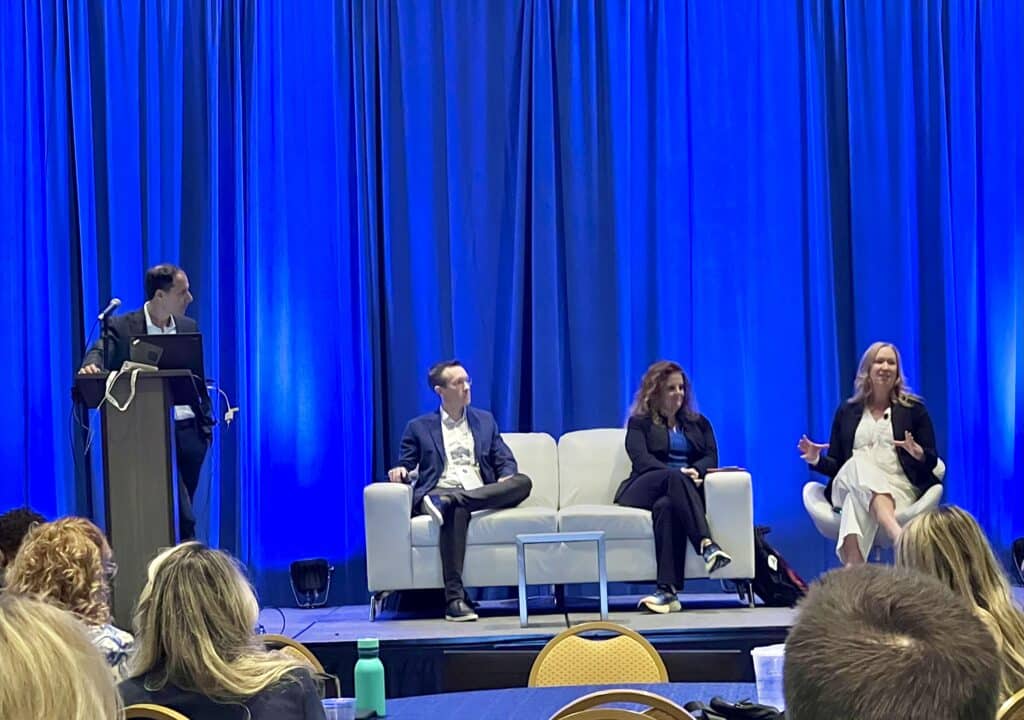
In litigation the integration of eDiscovery and case management has become increasingly crucial. This session at ILTACON 2024 explored this vital connection, offering insights on how legal professionals can streamline the litigation lifecycle by aligning eDiscovery practices with case management workflows.
The current state of alignment
The presentation began with a stark revelation – when asked, only one attendee indicated that their firm’s eDiscovery and case management processes were aligned. This highlights a significant opportunity for improvement across the legal industry.
Achieving better alignment may require us to reframe the way we think about case management. Case management shouldn’t be viewed as the step after eDiscovery, because it encompasses the entire case lifecycle from analysis to strategy and application of law. With this in mind, teams can more easily connect early-stage discovery with case outcomes.
It’s also noteworthy and significant that litigation teams are facing a growing volume of data. This has necessitated technological advancements in eDiscovery and law firm operations. There’s a notable disparity between the amount of data provided upfront and the truly valuable, dispositive information. As one presenter astutely noted, “We are drowning in information but have very little knowledge.”
Developing an effective plan
To bridge the gap, legal teams must develop comprehensive strategies, here are some key recommendations.
Understand the big-picture process
In discovery you should already be thinking about how to move your case forward. Understanding the scheduling order provides direction and context for your role within the case strategy. By anticipating the next steps in the process, you can move from a reactive to a proactive approach.
Create the chronology and cast of characters early
Documents and data are more reliable than human memory, so building a case chronology and understanding the cast of characters early on can help maintain momentum through all phases of case management.
Tie costs to data practices
One of the most frequent questions discovery clients ask is: How much is this case going to cost? Often, the answer isn’t based on the type of case or matter, it comes down to the client’s document retention policy. To best answer the question, attorneys must ask clients a couple of questions like, How did you collect this data? And, is there a foundation system in place?
Exploring generative AI
The panel discussed generative AI (GenAI) at several points during the session. They noted that it is particularly suited for the exploratory and investigative stages of a case. However, among the audience, the current application of AI was limited, while many anticipated using AI in the near future.
AI has huge potential to eliminate or streamline the low-value, tedious work that is often written off. One key use case is that AI can quickly identify and discard irrelevant documents. Automating this task can save hours and would allow the team to spend more time on high-value client work.
Additionally, the panel emphasized the importance of human guidance when using AI. Teams must find intuitive ways to incorporate that element of human guidance into their workflows because lawyers don’t have time to actively “train up” GenAI models. The group also discussed the impact of discovery data quality on downstream uses of AI quoting the adage, “garbage in, garbage out” noting that AI outputs are only as good as the underlying data.
Transforming raw data into decisive legal action
As the legal industry continues to grapple with ever-increasing data volumes, the alignment of eDiscovery and legal case management becomes not just beneficial, but essential. By embracing new technologies, developing comprehensive strategies, and maintaining a focus on high-value work, legal professionals can transform raw data into decisive legal action, ultimately serving their clients more effectively and efficiently.

Traci Hewitt
Client Relationship Manager
Unmasking the impostor: Fostering confidence in women in tech
Speakers
- Tiffany Pereira | VP, Customer Success | MinuteBox
- Melanie Prevost | Senior Director of Infrastructure and Technical Support Services | Vinson & Elkins, L.L.P.
- Maribel Rivera | VP, Strategy and Client Engagement | Association of Certified E-Discovery Specialists
- Candi Smith | eDiscovery Analyst | The Walt Disney Company
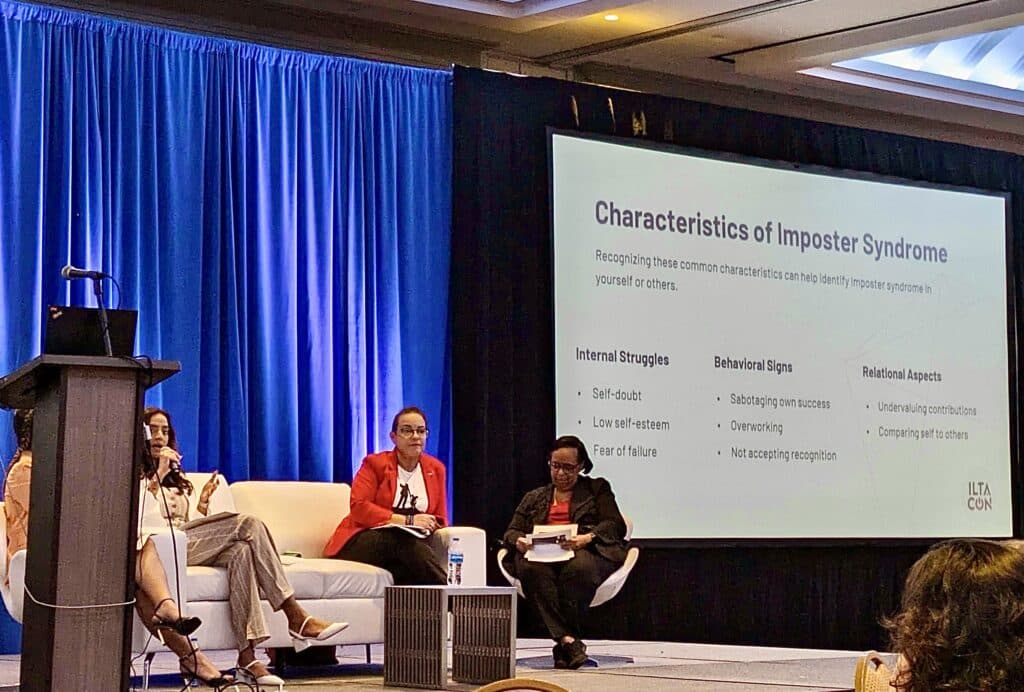
In this session at ILTACON 2024, industry leaders tackled the pervasive issue of impostor syndrome, particularly as it affects women in the technology sector. Speakers in this session explored the origins, impact, and strategies women can use to overcome this phycological phenomenon.
Understanding impostor syndrome
Impostor syndrome, first identified in a 1978 study, is characterized by persistent self-doubt and feelings of inadequacy despite evident success. While initially focused on white women, subsequent research has shown that it impacts individuals across all identities. However, it disproportionately affects women and marginalized groups:
- Nearly 75% of female executives experience impostor syndrome
- 54% of women versus 38% of men face these feelings
Melanie Prevost, Senior Director of Infrastructure and Technical Support Services, Vinson & Elkins offered an important reminder to attendees, “These are internal feelings. The person questioning you is yourself. You really have to understand where these feelings are coming from.”
The many faces of impostor syndrome
The session outlined five types of impostor syndrome including the perfectionist, the superhuman, the natural genius, the expert, and the soloist.
Each type manifests differently, but all share common characteristics such as self-doubt, fear of failure, and difficulty accepting recognition. The speakers also introduced the four Ps of impostor syndrome which include perfectionism, procrastination, project paralysis, and people pleasing.
Addressing the last point, Prevost emphasized “You can’t please everyone. You just can’t. The trap in that is you’ve already put yourself at a disadvantage because you are trying to achieve the impossible.”
The impact on women in tech
The session highlighted how impostor syndrome particularly affects women in the tech industry, where they are historically underrepresented. Challenges include:
- Stereotypes and bias
- Isolation in male-dominated environments
- Lack of female role models
Sharing her personal experience, Prevost noted, “Typically I’m the only female in the meeting. It brings on two feelings: isolation because you’re alone… and lack of role models. I had to really make a decision and that was I was going to be my own role model.”
Tiffany Pereira the VP, Customer Success at MinuteBox powerfully stated, “Innovation is truly stalled by impostor syndrome.”
The discussion also touched on the additional layers of complexity faced by women of color, including double minority status, stereotype threat, and fewer mentors in leadership positions.
Strategies to combat impostor syndrome
For those who find themselves facing the challenges posed by impostor syndrome can focus on these strategies.
- Continuous learning and skill development
- Recognizing and leveraging unique strengths
- Thorough planning to boost confidence
- Building a supportive network of peers and mentors
- Accepting imperfection and shining unapologetically
This session provided a comprehensive look at impostor syndrome and its particular impact on women in tech. By understanding its origins, recognizing its various manifestations, and implementing strategies to combat it, women can build confidence and thrive in their tech careers.

Olivia Corazzin
Marketing Manager, Software
Wrapping up ILTACON 2024, and looking forward to ILTACON 2025
Reflecting on ILTACON 2024, it’s clear that big things are coming in legal tech. Over the next year, attendees will explore the ideas these sessions sparked, optimize processes, and pursue continued innovation. We can’t wait to see what’s next, and we’re already looking forward to ILTACON 2025.

